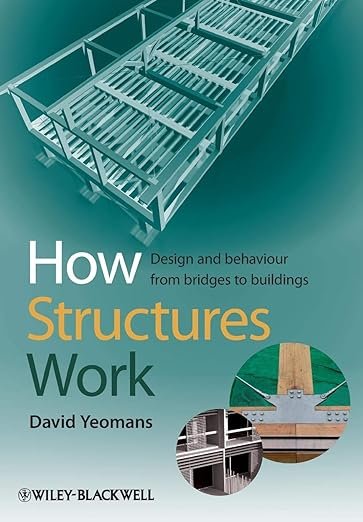How Structures Work: Design and Behavior from Bridges to Buildings 1st Edition
The alliance between architecture and structural engineering is fundamental to the design of the buildings and bridges around us. Anyone who needs or wants to understand a building must have a good understanding of the structural concepts involved. Yet structure is often cloaked in mathematics which many find difficult to get to grips with.
How Structures Work has been written to explain the behaviour of structures in a clear way without resorting to complex mathematics. Using the minimum of mathematics it explains the structural concepts clearly, illustrated by many historical and contemporary examples, allowing readers to build up a general understanding of structures. In this way they can easily comprehend the structural aspects of buildings for themselves.
Primarily aimed at students who require a good qualitative understanding of the behaviour of structures and their materials, it will be of particular interest to students of architecture and building surveying, plus architectural historians and conservationists. The straightforward, non-mathematical approach ensures it will also be suitable for a wider audience including building administrators, archaeologists and the interested layman.
Editorial Reviews
Review
?The reader can equally well read How Structures Work straight through or pick it up and wade in almost randomly. There are no two consecutive pages without some enlightenment.? ( Timber Framing, December 2009)
From the Back Cover
The alliance between architecture and structural engineering is fundamental to the design of the buildings and bridges around us. Anyone who needs or wants to understand a building must have a good understanding of the structural concepts involved. Yet structure is often cloaked in mathematics which many find difficult to get to grips with.
How Structures Work has been written to explain the behaviour of structures in a clear way without resorting to complex mathematics. Using the minimum of mathematics it explains the structural concepts clearly, illustrated by many historical and contemporary examples, allowing readers to build up a general understanding of structures. In this way they can easily comprehend the structural aspects of buildings for themselves.
Primarily aimed at students who require a good qualitative understanding of the behaviour of structures and their materials, it will be of particular interest to students of architecture and building surveying, plus architectural historians and conservationists. The straightforward, non-mathematical approach ensures it will also be suitable for a wider audience including building administrators, archaeologists and the interested layman.
About the Author
David Yeomans is an engineer and an historian. He taught structural design at the Oxford and Liverpool Schools of Architecture and building construction, history and building conservation at Manchester University.
He currently teaches on the MSc course in timber conservation at the Weald and Downland Museum (run on behalf of Bournemouth University) and is also Senior Research Fellow at Liverpool University. He also practices as a structural engineer specializing in timber structures both new-build and conservation work. He is secretary of the International Scientific Committee for the Analysis and restoration of Structures of Architectural Heritage, which is an ICOMOS scientific committee.
Product details
- Publisher : Blackwell Pub; 1st edition (January 1, 2009)
- Language : English
- Paperback : 248 pages
- ISBN-10 : 1405190175
- ISBN-13 : 978-1405190176
- Item Weight : 1.05 pounds
- Dimensions : 6.75 x 0.25 x 9.5 inches

















Reviews
There are no reviews yet.